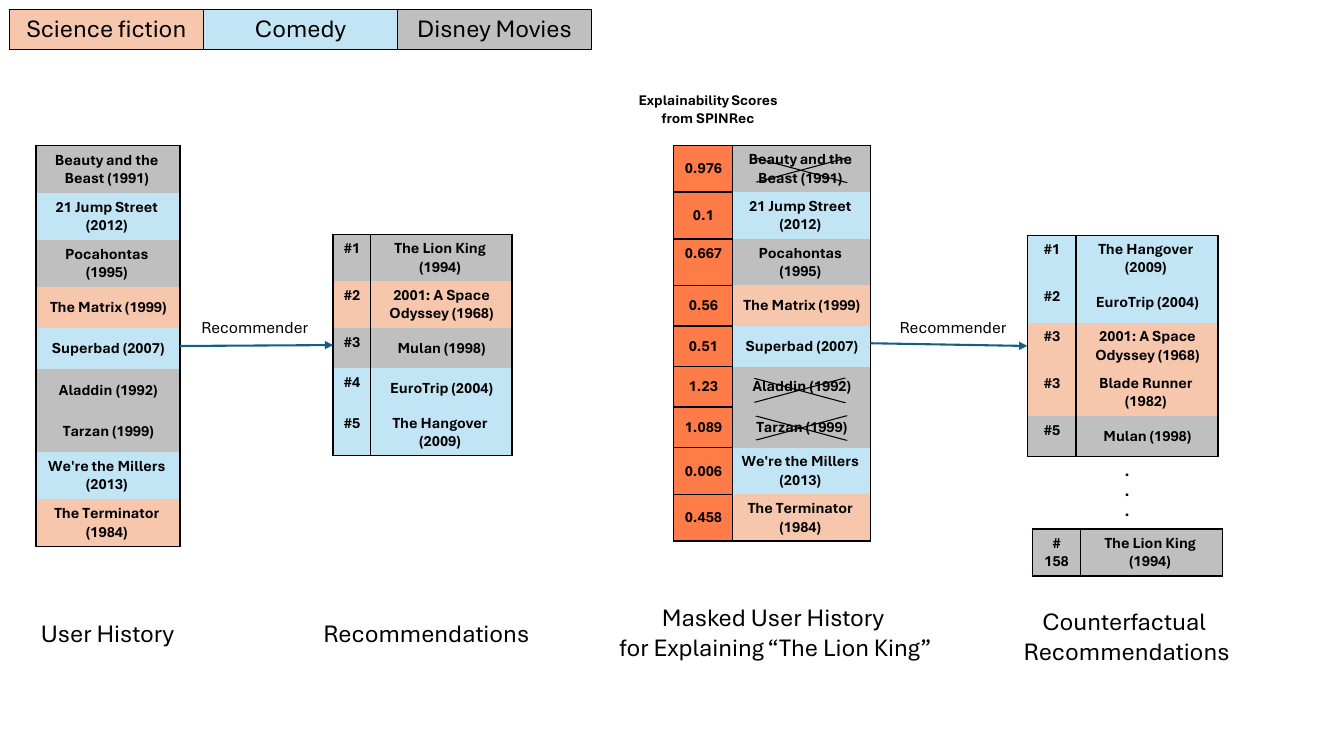Oren Barkan Yahlly Schein Yehonatan Elisha Veronika Bogina Mikhail Baklanov Noam Koenigstein

الملخص
فيما يلي ترجمة النص إلى اللغة العربية، مع الالتزام بالأسلوب الأكاديمي والتقني الرصين:تظل موثوقية التفسير (Explanation fidelity)، التي تقيس مدى دقة عكس الشرح للاستدلال الحقيقي للنموذج، مجالاً لم يحظَ بالبحث الكافي وبشكل حاسم في أنظمة التوصية (Recommender Systems).نقدم في هذا العمل SPINRec (تكامل المسار العشوائي لتفسيرات التوصية العصبية)، وهو نهج غير مرتبط بنموذج محدد (model-agnostic) يعمل على تكييف تقنيات تكامل المسار (path-integration) لتتلاءم مع الطبيعة المتناثرة والضمنية لبيانات التوصية. وللتغلب على قيود الأساليب السابقة، يوظف SPINRec تقنية أخذ عينات خط الأساس العشوائية (stochastic baseline sampling): فبدلاً من التكامل انطلاقاً من خط أساس ثابت أو غير واقعي، يقوم النموذج بأخذ عينات لعدة ملفات تعريف معقولة للمستخدمين من توزيع البيانات التجريبي (empirical data distribution) ويختار مسار العزو الأكثر موثوقية. يتيح هذا التصميم التقاط تأثير التفاعلات المرصودة وغير المرصودة على حد سواء، مما يؤدي إلى تقديم تفسيرات أكثر استقراراً وتخصيصاً.لقد أجرينا التقييم الأكثر شمولاً للموثوقية حتى الآن عبر ثلاثة نماذج (MF, VAE, NCF)، وثلاث مجموعات بيانات (ML1M, Yahoo! Music, Pinterest)، ومجموعة من المقاييس المضادة للوقائع (counterfactual metrics)، بما في ذلك منحنيات الاضطراب القائمة على المنطقة تحت المنحنى (AUC-based perturbation curves) والتشخيصات ثابتة الطول. أظهر SPINRec تفوقاً مستمراً على جميع النماذج المرجعية (baselines)، مما يرسّخ معياراً جديداً لقابلية التفسير الموثوقة (faithful explainability) في مجال التوصيات.الكود البرمجي وأدوات التقييم متاحة للعموم على الرابط: https://github.com/DeltaLabTLV/SPINRec
Summarization
Researchers from The Open University of Israel and Tel Aviv University introduce SPINRec, a model-agnostic framework that enhances explanation fidelity in recommender systems by employing stochastic baseline sampling to integrate attribution paths from plausible user profiles rather than relying on fixed or unrealistic baselines.
Introduction
As recommender systems increasingly shape user decisions in e-commerce and media, the demand for transparency has shifted focus from simple persuasiveness to fidelity, ensuring that explanations accurately reflect the model's actual decision-making process. However, applying established attribution techniques like Path-Integration (PI) to this domain is challenging because recommendation data is inherently sparse and binary. Standard PI methods, which rely on "all-zero" baselines, fail to capture the nuance of user interactions in this setting, often resulting in weak or misleading attribution signals.
To address this gap, the authors introduce SPINRec (Stochastic Path Integration for Neural Recommender Explanations), a novel framework that adapts Path-Integration specifically for neural recommenders. By moving away from static baselines, the authors provide a method that respects the unique data structure of recommendation engines.
Key innovations and advantages include:
- Stochastic Baseline Sampling: Instead of relying on an unrealistic all-zero baseline, the model samples multiple plausible user histories from the empirical data distribution to generate more stable and informative gradient signals.
- Domain-Specific Adaptation: The framework is the first to successfully adapt Path-Integration from computer vision and NLP to recommender systems, specifically addressing the challenges of high-dimensional, sparse, and binary data.
- Superior Fidelity: Extensive evaluations across multiple architectures (including Matrix Factorization and VAEs) and datasets establish SPINRec as the new state-of-the-art benchmark for counterfactual explanation fidelity.
Dataset
The authors conduct experiments using three distinct datasets: ML1M (MovieLens), Yahoo! Music, and Pinterest. The data preparation and evaluation strategy involve the following steps:
- Data Processing: All datasets are binarized to convert interactions into implicit feedback.
- Splitting Strategy: The researchers apply an 80/20 user-based split to divide the data into training and testing sets.
- Validation: An additional 10% of users are withheld from the training data to serve as a validation set for hyperparameter tuning.
- Evaluation Scope: Results are reported on the test set, with explanations specifically targeting the top recommendation for each user.
Method
The authors leverage path-integration methods to develop SPINRec, a framework for generating explanations in recommender systems. The core approach computes feature attributions by integrating gradients along a path from a baseline user representation to the actual user data. Given a user's binary feature vector x and a target item y, the predicted affinity fθy(x) is decomposed into contributions from individual features using a straight-line path r(t)=t⋅x+(1−t)⋅z, where z is a baseline vector and t∈[0,1]. The attribution for each feature is derived from the integral of the gradient of the model's output with respect to the interpolated input, weighted by the path's derivative. This results in an explanation map m, which quantifies the relevance of each feature to the recommendation, as defined in Equation \ref{eq:expl_map}.

Experiment
- The study evaluates the counterfactual fidelity of SPINRec across three datasets (ML1M, Yahoo! Music, Pinterest) and three recommender architectures (Matrix Factorization, VAE, NCF), comparing it against state-of-the-art baselines including LXR, FIA, and SHAP.
- On AUC-based fidelity metrics, SPINRec achieved the best results across all models and datasets, statistically surpassing strong baselines like LXR and FIA (p≤0.01).
- In fixed-length metric evaluations (POS, DEL, INS, CDCG), the method consistently outperformed all baselines across varying explanation lengths (Ke) and ranking cutoffs (Kr), demonstrating robustness in identifying high-impact features.
- Ablation studies validated the contribution of stochastic baseline sampling, showing that SPINRec significantly outperforms plain path integration (PI) by leveraging unobserved interactions, with performance gains most pronounced in complex models like VAE and NCF.
The authors use counterfactual fidelity metrics to evaluate explanation methods across multiple recommendation models and datasets, with results showing that SPINRec consistently outperforms all baselines in both AUC-based and fixed-length metrics. Across all configurations, SPINRec achieves the best performance, particularly in metrics like POS@K and CDCG, demonstrating superior fidelity in explaining recommendation outcomes.

The authors use counterfactual fidelity metrics to evaluate explanation methods across multiple recommendation models and datasets, with results showing that SPINRec consistently outperforms all baselines in both AUC-based and fixed-length metrics. Across all configurations, SPINRec achieves the best performance, particularly excelling in metrics like POS@K and CDCG, while also demonstrating robustness across different recommendation architectures and datasets.

بناء الذكاء الاصطناعي بالذكاء الاصطناعي
من الفكرة إلى الإطلاق — عجّل تطوير الذكاء الاصطناعي الخاص بك من خلال البرمجة المشتركة المجانية بالذكاء الاصطناعي، وبيئة جاهزة للاستخدام، وأفضل أسعار لوحدات معالجة الرسومات.